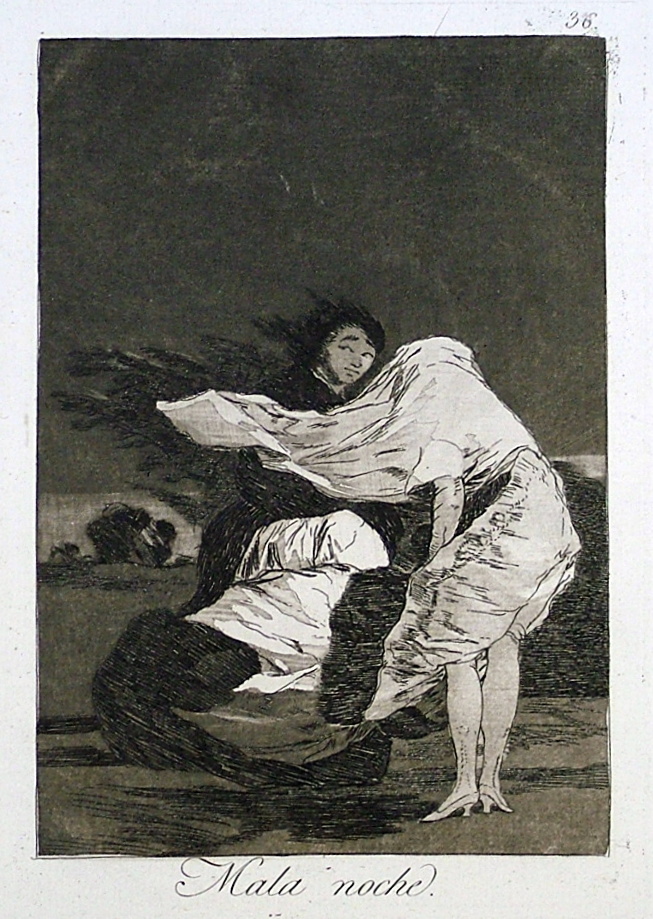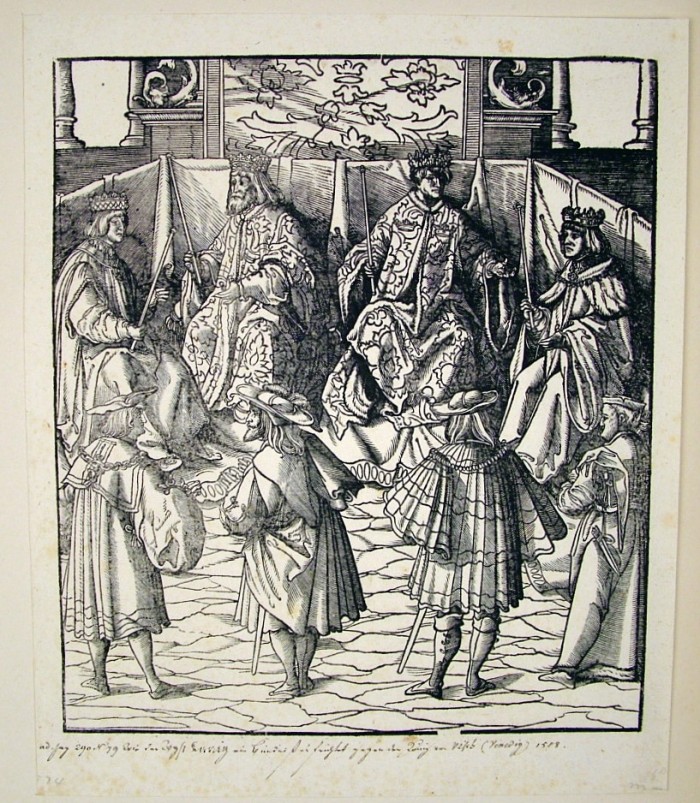An Introduction to Goya’s Aquatint sets
Thursday, January 29th, 2009
I get many questions about Goya prints, so thought it might be useful to sketch an overview of some of his most famous and common prints: the aquatint sets. Francisco Goya (1746-1828) was of course one of the greatest of Western artists, and printmaking was central to his career. He created four major series of prints, and many other prints including a series of lithographs late in his career. Due to the way most of his prints were created and published, there is much confusion today about their dating, their rarity, their appearance and their value. In this guide I want to clarify some of the connoisseurship issues (ignoring for the moment the art historical and aesthetic issues) regarding the four major Goya print series: the Caprichos, Disasters of War, La Tauromaquia, and Los Proverbs (or Disparates). I’ll begin with a few notes on his basic printmaking method, then discuss the four series in turn.
Goya’s Printmaking Methods
Goya’s four major print series were each done in engraving. He worked, generally after making a preliminary drawing for guidance, on a copper plate. After damping the paper and putting a wax-like ground on the plate he would put the drawing face down on the plate, and run the paper and plate through a press. A copy of the drawing would transfer to the ground. He would then work over the lines on this ground with an etching needle; when put in acid the plate would be protected except where lines were drawn, and furrows would be eaten away by the acid. When the ground was taken off the plate, the plate would be inked and these furrows would hold ink even after the plate was wiped; a sheet of damp paper pressed over the inked plate would then pick up the lines of ink. This is the basic etching process.
The etching process creates lines on the plate; to get areas of shading, Goya used the method of aquatint. Here areas of the plate are grained and bitten with acid to roughen the plate surface so it will hold ink and print as tone. He probably applied resin to the plate after putting resin in a muslin bag, then shook it onto the plate. The plate would then have lots of tiny grains. Then the plate was warmed so that the resin
melted to the plate and stuck. When acid is then applied to the plate, it works around these grains, eating into the plate and creating areas of lots of tiny holes. If the acid is applied to an area twice or bathed in acid for a longer time, the holes would be deeper, and hold more ink – this area would print darker than the more lightly bathed area.
Goya worked on the plates in other ways to strengthen lines, to burnish away areas of aquatint or soften lines; he sometime also worked with a drypoint needle directly on the plate to get details right. So although his central method was aquatint, he worked over the plates in many ways to get the image and effects he wanted. But the pressure of the printing process takes its toll on copper plates, and these subtle effects – especially those in aquatint, which creates rather shallow pits in the plate – are lost after a large number of printings. My major point: all the work Goya did gets worn down as the plates wear over time, and tired, hazy impressions without contrast are the result. Now let’s look at the prints.
Los Caprichos
Los Caprichos, the earliest of the major Goya series, is a series of 80 engravings, published initially in 1799 by Goya himself. Goya produced a number of working proofs for these engravings, without the letters found on the bottom margin or the numbers at the top. Only two are known before aquatint. Then letters were added; more trial proofs taken and the letters on a number of these proofs corrected. These early proofs, and a few complete early sets, are fairly well documented; their location is known. In 1799 the prints were published in an edition of about 300, on fine quality strong laid paper, the sheets measure about 320 by 220 mm, in a warm sepia ink. These prints, in the First Edition, are each (of course) lifetime impressions. They vary a bit in quality, for as the run went into the hundreds the aquatint began to wear out, the different layers of shading became less distinct. But in general these prints are fine impressions.
In 1855, long after Goya’s death, the Calcografia in Madrid issued another set of Los Caprichos, now on wove paper. This edition was small, and the quality was generally good although variable. But the prints are not comparable to those of the First Edition. The Calcografia produced another edition (the Third Edition), also on wove paper, in 1868. Further editions were done in the late 1800’s, with various inks, still on wove paper, and the plates continued to deteriorate. The plates were then steelfaced (a tiny layer of steel applied to them, to halt the deterioration). More additions were produced by the Calcografia, with various papers, watermarks, sizes and inks, up through the 12th Edition, issued in 1937.
All of these posthumous edition impressions are in some sense “original Goya prints,” i.e., they were taken off of the original plates. The editions, almost all originally in bound volumes of 80, have been broken up and impressions are sold singly. Connoisseurs of course prefer the impressions from the First Edition, and the earlier impressions from that edition if possible.
The Disasters of War
This second series of Goya prints has a quite different history from the Caprichos. Again, it is a series of 80 prints, but produced over a longer period, from about 1808 to 1814, the period of the Napoleonic Wars and the Great Famine in Madrid in 1811-12. Working materials were scarce, and Goya worked on used plates, often cutting them in half or working on the back of worn or defective plates. This shows in the results; even the earliest impressions generally lack the incisiveness, and clarity of aquatint shading, of the Caprichos plates. But given the subject matter and the nature of the materials Goya worked with this series remains one of the great artistic and printmaking achievements.
Goya produced trial proofs, and even some complete proof sets of the Disasters after all the plates were completed. But he did not have an edition published at that point, or later during his lifetime. He left for France in about 1820, and had the plates stored in safes by his son, Javier. After Javier’s death in 1854 the plates were acquired by the Academia de San Fernando. At this point the plates were washed and proofs taken in preparation for an edition. Trial proof sets were made for the edition (a small number are documented), before the letters in the bottom margin were added. Then First Edition sets were printed (in 1862-3); some sets made before corrections in the lettering of some of the plates, a later group after the corrections. The size of these first two editions is about 500. These were done on wove paper, many with JGO and palmette watermarks, in a sepia ink.
After the First Edition six more editions were published, of varying quality on a variety of papers, through the Seventh Edition in 1937. The editions did not get worse uniformly after the First, but, as in the case of the Caprichos, the First is by far more desirable (and of course the lifetime proofs are most desirable of all).
La Tauromaquia
The 33 original plates of this series were created in about 1815-1816, and were printed in an edition by Goya at that time (he produced a number of additional plates but rejected them), after a number of proof impressions were made. The set is on fine laid paper, with certain watermarks, printed in sepia ink. The edition was very small, perhaps much smaller than the Los Caprichos edition of 300. As with the other series, the Calcographia produced additional editions, starting with a small one in 1855 (on wove), a Third in 1876 (on laid), up to a Seventh in 1937. For the printing of the Third Edition the printer got ahold of seven of the previously rejected plates (actually printed on the back of seven of the original plates) and printed them (lettering them A-G) as part of a set, making the total 40. These latter plates were not, then, editioned during Goya’s lifetime.
Los Proverbios
The eighteen Proverbios prints were made at various times from about 1815-1824. Like the Disasters series prints, a few proofs were made of these prints by Goya, but no edition produced. The plates were then stored, with the plates of the Disasters, by his son Javier, and re-discovered after Javier’s death. It’s a mystery why a lifetime edition was not produced. Trial proofs were printed prior to the publication of the First Edition in 1864. After publication of the First Edition (in an edition of 300) an additional four plates were discovered in the possession of an artist, and these were published in L’Art in 1877, for the first time.
The plates of the Proverbios were re-editioned 8 times after the First Edition, the last edition in 1937, on various papers, different inks, and with widely varying results. As with each of the Goya sets, the deterioration after the initial printing – and even through the initial printing – was considerable.
I get more questions about Goya prints than almost any other artist. People typically have a print or two and wonder whether it’s lifetime or posthumous, valuable, a good example, a reproduction. This overview may provide some sense of the issues and complexities entailed in answering these questions. And if it leads you to contact me for further discussion – that’s fine! Harris Schrank


